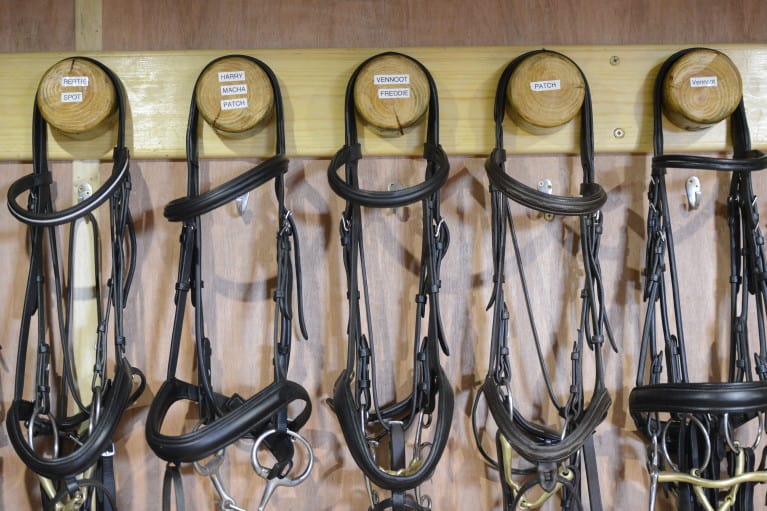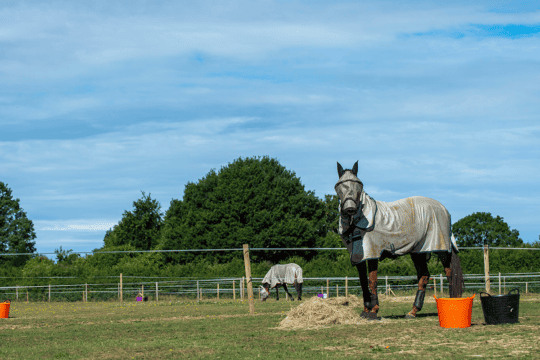Learn how to effectively and efficiently care for your leather tack with Jeffries Saddlery.

Kitting out your horse or pony with tack and clothing can easily cost as much as the animal itself with the saddle being the main investment.
Naturally most owners want to look after their equipment to ensure it is comfortable for the horse and to get the best out of it so it lasts for many years to come.
Looking After Leather
The correct care and maintenance of tack undoubtedly prolongs its life. Regular checks on the stitching and condition of the leather are also essential for safety.
All tack should be sponged off and wiped over after it has been used and the bit washed, then dismantled once a week into component parts and cleaned thoroughly to keep it in good order.
Daily Care
Saddles and bridles should be cleaned after use whilst they are still warm as the dirt is easier to remove.
Begin by rubbing over the leather with a damp towelling cloth or sponge to remove any dirt, then work saddle soap into both sides of the leather, paying special attention to any folds and bends. A glycerine based soap is considered the best for removing sweat and grease from the surface of the leather. Care should be taken that leather doesn’t become too wet and soapy.
You should pay particular attention to the condition of the leather on the reins, which may become worn and thin around the bit and also inspect the billet, linings and the security of the hook stud. Ensure the girth straps and stirrup leathers are fit for purpose for safe and secure riding.
Also check the stitching on the saddle and attend to any signs of wear immediately before the tack becomes unsafe.
Metal work should be washed in warm water and dried carefully. Metal polish can be applied to give it a shine, but avoid using it on mouthpieces.
If rubbers are used in the stirrup irons, remove them and wash and dry them before replacing.
Girths made of webbing, string or nylon should be brushed off after use and given a chance to dry and air. Wash if necessary, but not in strong soap powders or detergents which may cause a reaction.
Leather girths should be inspected for any signs of wear and check the stitching around the buckle area, also check any elastic inserts for wear. Always clean regularly so as to keep your girth soft and supple. This will help avoid any sores and rubs.
Numnahs should be kept dry, clean and soft. Once they become rough they can cause a sore back and defeat their purpose. Regular brushing with a stiff brush or combing with a plastic curry comb will keep sheepskin soft. Again, many can be washed in a machine, but sheepskin is best washed by hand and allowed to dry naturally.
Weekly Care
At least once a week all bridlework should be dismantled completely, inspected and cleaned thoroughly following the procedure above.
It is also best to undo the hook studs on the end of cheekpieces and reins so you can clean the linings on the insides of the turns and keep them easily workable.
Remove any soap out of the holes with a matchstick or cocktail stick and buckles can be cleaned with a metal polish.
Always inspect the tack for worn stitching, fraying and cracked leather.
Oiling
Many horse owners fail to recognise the damage that over-oiling leather can do. This common mistake results in a radical change in the fibrous structure, weakening and distorting it. Many neats foot oil compounds and blends contain mineral oils. These will have a detrimental effect on your Saddlery.
However obvious it may seem, the key to long-term care and maintenance is to feed the leather with the same ingredients which were used to prepare the hides for making the original riding equipment.
Jeffries takes the quality and efficacy of their leather riding equipment very seriously indeed and takes great pride in sending out consistently fine products to retailers.
Because all leather problems are not so easily solved, Walsall-based Jeffries and their specialist equestrian curriers, research the causes and analyse them minutely.
The curriers use natural oils and fats to impregnate the hides in processes that ensure the natural fibres in the leather are consistently meshed together, without separating. The preparation results in hides that are flexible, supple and resilient with a high tensile strength.
By working closely with curriers who supply many of their best hides, Jeffries has developed a leather dressing which contains the same ingredients used in the original preparation of the leather. Beeswax is used to seal the finished product, this helps repel water and adds a fine sheen to its appearance.
Jeffries’ advice on the care and maintenance of leather riding equipment is very simple. Wipe tack clean with a damp sponge or cloth and leave to dry naturally away from a heat source. Apply Jeffries Natural Leathercare sparingly and evenly to both the grain (top) and the flesh (back) of the leather and when touch-dry, buff with a dry cloth.
Storage
When storing tack for any length of time, avoid a hot atmosphere as this will dry out the leather and cause damage to the stitching, or damp conditions which will quickly result in the growth of mildew. A dry place of moderate temperature is best.
Tack should be cleaned and dried thoroughly and wrapped in cotton material. For example a bridle bag and saddle cover, not in plastic as this will cause the leather to sweat.
Jeffries Natural Leathercare can be applied to the leather to protect it and keep it supple. Vaseline can be used to protect steel fittings. If possible, regular checks should be made to ensure there is no dampness or damage from vermin.















